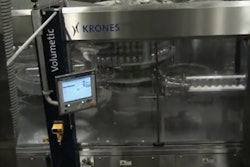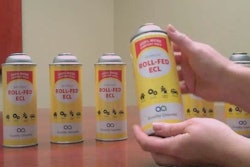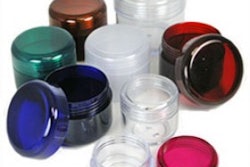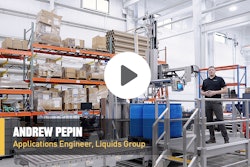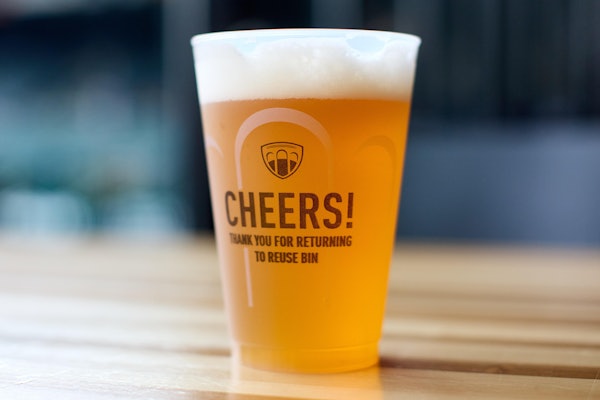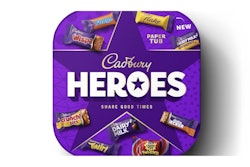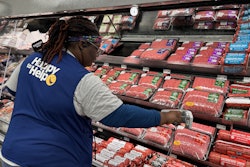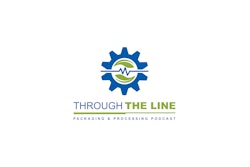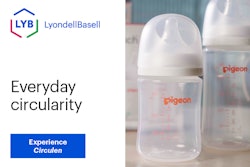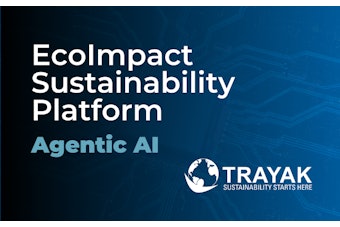"Because we can do things in-house, we're able to do them right away."
That simple statement by project manager James Gott of Ice River Springs neatly captures the essence of this ambitious, successful, and growing Canadian firm. On the surface, it's a bottled water company headquartered near a springwater source in an Ontario town called Feversham. But if you look a little deeper, you find they are also cap makers, preform molders, bottle blow molders, and—most recently—post-consumer PET recyclers without equal. As if all that weren't enough, their next project is self-manufacture of shrink bundling film. It will be made, of course, from recycled content.
The focus of this story, however, is on bottle-to-bottle recycling of PET. It started for Ice River about three years ago when the firm began buying recycled material from outside producers.
"Our supplier of RPET was always very cautious about the amount of recycled content that could be mixed with virgin," says Gott. "It seemed like they didn't want to go much past 20% RPET. We kept pushing them, even going so far as to get involved in some development work with the companies that make the injection molding machines used to make the preforms."
Before too long, Gott and company realized that they'd never get to 100% RPET bottles as long as preforms were being made from RPET flake. "We got as high as 50% RPET, but if we tried any higher, there was insufficient injection pressure on the molds," says Gott. "So we knew we had to go from flake to pellet to preform instead of flake directly to preform."
Also troublesome at the time, says Gott, was that the Ohio RPET supplier on which Ice River depended was getting most of its baled PET from Ontario. Why? Because the well-established curb-side collection and sortation system in Ontario results not only in a lot of volume where RPET is concerned but also a level of quality that was difficult to find in the U.S. Realizing that it was inherently unsustainable to ship RPET from Ontario to Ohio and then back to Ontario, Ice River saw an opportunity to get into the business of producing its own RPET and eliminate some wasteful truck transport. The ultimate goal? "To convert all of our business over to recycled resin," says Gott. "The idea is to stop buying virgin resin."
October startup
This past October, the first supplies of 100% PCR PET began flowing from Ice River's impressive recycling system into its preform injection-molding machines and then into its blowing and filling lines. While an Amut wash line and a Starlinger extruder/pelletizer system are perhaps the central components in the lengthy sequence of machinery through which the material passes, there were about a dozen companies involved, says Gott. It also requires two separate facilities.
"We quickly realized that we didn't want incoming bales of post-consumer materials anywhere near our food-grade water-bottling operations," says Gott. "So in March of 2010 we bought a 180,000 square foot plant in Shelburne, 20 minutes south of our Feversham bottling plant. It had housed an auto parts manufacturer that had just shut down its operations. The beauty of Shelburne is that it's right on the truck route that connects our Feversham plant with Toronto, where so many of the MRFs (Material Recycling Facilities) are located. So now instead of delivering water to Toronto and returning to Feversham empty or half empty, our trucks pick up baled PET and drop it in Shelburne. And while in Shelburne, they pick up supersacks of clean flake that the Shelburne plant has produced. Then the trucks continue on to Feversham, where the clean RPET flake is further processed, pelletized, and made into new bottles ready for shipment to Toronto. It's a closed loop."
Government-run, or run by companies under government contract, the MRFs are a pretty mixed bag when it comes to automated sortation. Some are highly automated and efficient at producing streams of homogeneous material, whether it's PET, aluminum, HDPE, or whatever; they bale this material and sell it to whomever needs it. Other MRFs are less efficient in their sortation efforts, so the bales they sell to buyers like Ice River are a mix of materials. But no matter what kind of bale Ice River takes in, the firm is capable of sorting out one stream of clear PET and a second stream of green PET with remarkable and highly automated efficiency. The green PET is ground, flaked, washed, and sold; it can be produced at up to 500 kg (1,100 lb)/hr. Non-PET material is re-baled and sold, as well. Only clear PET, which the Shelburne plant can produce at a rate of 3,400 kg (8,000) lb/hr, goes on to Feversham.
But before Feversham is Shelburne, and the first step at Shelburne is bale breaking. It's followed by caustic wash for label removal, computerized optical sortation, grinding, float-sink/separation, friction washing, a second float/sink tank, centrifugal rinse, flake drying, flake mixing, metal detection, computerized optical sorting to eliminate colored flake, and, finally, bulk packing of clean flake into supersacks ready for transport to Feversham. This entire process is the responsibility of Amut, a firm based in Italy. But a number of equipment manufacturers are involved as subcontractors to Amut.
Once past the Machinex bale breaker, containers are all individual units flowing down a wide conveyor belt. Magnets above the conveyors attract and remove any steel that may still be present. Washing is next, which takes place on an Amut high-friction whole-bottle washer.
Label removal
"The idea is if there are labels attached, we like to get that stuff separated before we move to sortation," says Gott. "First is a prewash chamber, which is like a big washing machine that uses blades to knock the bottles around. It also sprays them with caustic soda, which dissolves label adhesive and causes labels to fall off. Next is a ballistic separator that agitates the bottles to help remove the labels. Then the bottles move on to three accelerating conveyors that space them out so that sortation can be done."
It's important to point out that the water used in the caustic wash is "spent" water. In other words, it's introduced near the end of the wash process, when the PET flake is nearly clean, and flows backwards. It gets progressively more contaminated as it proceeds backwards, but it is still perfectly suitable for the job it must do at each of four stages. According to Amut, Ice River's Shelburne operation uses 1 pt of water to produce 1 lb of clean flake.
The ultimate goal is to produce three streams of material:
• Clear and blue PET
• Green PET
• Other (mostly polyolefins used to make milk jugs or caps, but also bits of paper, aluminum, or steel that make it through)
If blue PET existed in huge volumes in the marketplace, it would have to be separated from the stream of clear PET. But because it's relatively uncommon, separating it from the clear PET is not necessary. In fact, says Gott, "We want a little blue mixed in with the clear. It counteracts the slight yellowing that might occur when the clear PET is subjected to the temperatures it sees later in the process."
To produce the three material streams it requires, Ice River uses two computerized optical sorters from Titech spaced about 20 ft apart. Using near infrared technology to identify the specific infrared spectra of objects passing beneath them, the Titech systems identify clear PET, non-clear PET, metal, paper, and plastics that are not PET. For every part identified that is not clear PET, a signal is sent to a PC that in turn sends a signal to an array of air jets instructing specific jets to fire, thus blasting parts that are not clear PET down through a gap in the conveyor connections on which the bottles are carried. With two identical optical sorters placed a short distance apart, whatever non-clear PET bottles the first one misses the second one gets. All rejected bottles go through a third Titech optical sorter that identifies any clear PET that has been rejected by mistake and air blasts it onto a conveyor that loops around to the main flow of clear PET.
Eventually, the three desired streams are created: clear PET (with a little blue mixed in), green PET, and non-PET. The non-PET material is re-baled and sold. Each of the two PET streams passes over a sort table where operators verify that the optical sorters didn't make any mistakes.
On to grinding
From here on the two streams of PET each goes through a nearly identical series of parallel but separate steps. It begins with wet grinding on equipment from Tria that transforms bottles into flake. Caps are ground up as well, though cap material is soon removed, as we shall see.
"At this point," says Gott, "rather than using conveyors, we actually use liquid conveying to take the flake from the bottom of the grinder through a pipe and up to the next step in the process, which is a float/sink tank. The nice thing about caps is they are not made of PET. So the cap material, usually PP, floats while the PET sinks to the bottom. We skim the floating cap material off the top and direct the PET stream to a friction washer from Amut that removes glue from the PET flake."
After the friction washer, a second float/sink tank ensures that non-PET material gets separated out. At this point the PET flake goes into a centrifuge for final rinsing. Out of the centrifuge is a flash dryer followed by a sizing table. Properly sized flake is piped to one of three mixing silos. Oversized flake—larger than 20 mm across—is diverted to a final grinder, back to the sizing table, and then to the mixing silos.
Supplied by Ariostea Systems, each of the three mixing silos holds about four hours of production, and each has an auger that gently mixes the flake. "The idea here," says Gott, "is that if we have one bale of bottles coming through the system that is particularly dense with green or blue bottles, there's a chance that the Titech optical sorters and the operators at the final sorting tables might let through an unusually high number of non-clear PET bottles. That translates into an unusually high concentration of non-clear PET flake, and you don't want that. It's the job of the silos to break down that high concentration by mixing together four hours worth of flake."
The reason for having three of the Ariostea silos is so that one can always be in the process of being filled, one can be in a mixing state, and one can be sending flake forward to the next step of the cleaning process. That next step is metal detection, and it's done by a computerized optical sorter from S+S similar to the one that detects and kicks out non-PET bottles near the beginning of the line. The key difference is that in this case it's metal flake that's being detected and rejected by bursts of air.
The final bit of separation technology, which comes from Buhler Sortex, is yet another optical sorter. But this time it's looking for color, green in particular, so that it can blast it out of the flow of clear material with a burst from an air nozzle. Finally, the flake flows into supersacks for transport to Feversham, where it goes from being "very clean" to being "food grade."
More metal detection
At Feversham, clean flake flows out of supersacks and through more metal detection. It's unlikely any metal has gotten past the sortation systems in place at Shelburne, but it's one of those just-in-case or fail-safe measures that seem to be in evidence throughout Ice River's operation.
Flake is augered up into predriers and then sent into a Starlinger extruder that melts the flake. The molten material is pushed through a melt filter and then into a pelletizer that cuts the plastic into beads. Done as it is under water, the process is also a cooling period for the pellets.
It's still not considered a food-grade material. So the pellets are put through what's called a solid-state polycondensation reactor, the Viscotec SSP from Starlinger. The pellets enter from the top and slowly settle down to the bottom over the course of eight hours. Throughout the time the pellets are in this system, they're constantly subjected to heat and vacuum pressure that either pulls out any contaminants that might be present or kills any bacteria.
Theoretically the material is already at a food-grade state even before it goes through the polycondensation reactor. But FDA requirements stipulate that this extra step be executed, says Gott. The Viscotec SSP system also addresses crucial material-behavior issues such as intrinsic viscosity and acetaldehyde reduction.
From here all that's left is injection molding of preforms on one of four Husky preform injection molding systems operated at the Feversham plant. "Our 500-mL preforms weigh 8.67 grams," says Gott. "We were also the first to lightweight our caps, which we also make, to one gram. So our bottle plus cap is under 10 grams. I think what's far more typical is in the range of 12 to 13 grams."
So what's next for this innovative and environmentally driven firm? A top priority is the rollout of 100% PCR RPET to all seven of its North American plants. Also on tap are solar panels on the roof and self-manufacturing of shrink bundling film.
"For us, sustainability is a real passion," says Jamie Gott, James Gott's father and the company president. "We're trying to lead ourselves and others to a zero carbon footprint."



